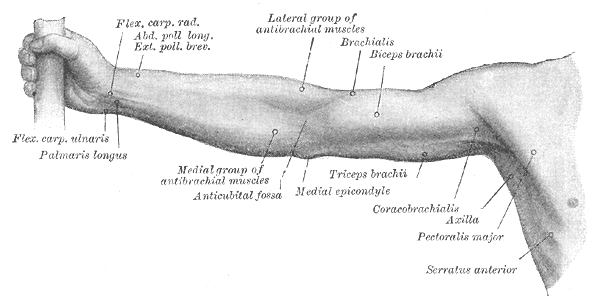[1]
Ellis H, Feldman S, Harrup-Griffiths W. The clinical anatomy of the antecubital fossa. British journal of hospital medicine (London, England : 2005). 2010 Jan:71(1):M4-5
[PubMed PMID: 20081653]
[3]
Tiwana MS, Charlick M, Varacallo M. Anatomy, Shoulder and Upper Limb, Biceps Muscle. StatPearls. 2023 Jan:():
[PubMed PMID: 30137823]
[6]
Lee H, Lee SH, Kim SJ, Choi WI, Lee JH, Choi IJ. Variations of the cubital superficial vein investigated by using the intravenous illuminator. Anatomy & cell biology. 2015 Mar:48(1):62-5. doi: 10.5115/acb.2015.48.1.62. Epub 2015 Mar 20
[PubMed PMID: 25806123]
[7]
Lieber RL, Fazeli BM, Botte MJ. Architecture of selected wrist flexor and extensor muscles. The Journal of hand surgery. 1990 Mar:15(2):244-50
[PubMed PMID: 2324452]
[8]
Tamgire DW, Sontakke YA, Rajasekhar S, Aravindhan K. A Unique Triad of Muscular, Vascular and Nervous Variations in Upper Limb. Journal of clinical and diagnostic research : JCDR. 2017 May:11(5):AD01-AD03. doi: 10.7860/JCDR/2017/25552.9927. Epub 2017 May 1
[PubMed PMID: 28658746]
[9]
Benham A, Introwicz B, Waterfield J, Sim J, Derricott H, Mahon M. Intra-individual variations in the bifurcation of the radial nerve and the length of the posterior interosseous nerve. Manual therapy. 2012 Feb:17(1):22-6. doi: 10.1016/j.math.2011.07.009. Epub 2011 Sep 7
[PubMed PMID: 21903444]
[10]
Dirim B, Brouha SS, Pretterklieber ML, Wolff KS, Frank A, Pathria MN, Chung CB. Terminal bifurcation of the biceps brachii muscle and tendon: anatomic considerations and clinical implications. AJR. American journal of roentgenology. 2008 Dec:191(6):W248-55. doi: 10.2214/AJR.08.1048. Epub
[PubMed PMID: 19020211]
[11]
Chakravarthi KK, Ks S, Venumadhav N, Sharma A, Kumar N. Anatomical variations of brachial artery - its morphology, embryogenesis and clinical implications. Journal of clinical and diagnostic research : JCDR. 2014 Dec:8(12):AC17-20. doi: 10.7860/JCDR/2014/10418.5308. Epub 2014 Dec 5
[PubMed PMID: 25653931]
[12]
Henry BM, Zwinczewska H, Roy J, Vikse J, Ramakrishnan PK, Walocha JA, Tomaszewski KA. The Prevalence of Anatomical Variations of the Median Nerve in the Carpal Tunnel: A Systematic Review and Meta-Analysis. PloS one. 2015:10(8):e0136477. doi: 10.1371/journal.pone.0136477. Epub 2015 Aug 25
[PubMed PMID: 26305098]
Level 1 (high-level) evidence
[13]
Yamada K, Yamada K, Katsuda I, Hida T. Cubital fossa venipuncture sites based on anatomical variations and relationships of cutaneous veins and nerves. Clinical anatomy (New York, N.Y.). 2008 May:21(4):307-13. doi: 10.1002/ca.20622. Epub
[PubMed PMID: 18428997]
[14]
Leung S, Paryavi E, Herman MJ, Sponseller PD, Abzug JM. Does the Modified Gartland Classification Clarify Decision Making? Journal of pediatric orthopedics. 2018 Jan:38(1):22-26. doi: 10.1097/BPO.0000000000000741. Epub
[PubMed PMID: 26974527]
[15]
Del Valle-Hernández E, Marrero-Barrera PA, Beaton D, Bravo D, Santiago S, Guzmán-Pérez H, Ramos-Alconini N. Complications associated with Pediatric Supracondylar Humeral Fractures. Puerto Rico health sciences journal. 2017 Mar:36(1):37-40
[PubMed PMID: 28266698]
[16]
Mukai K, Nakajima Y, Nakano T, Okuhira M, Kasashima A, Hayashi R, Yamashita M, Urai T, Nakatani T. Safety of Venipuncture Sites at the Cubital Fossa as Assessed by Ultrasonography. Journal of patient safety. 2020 Mar:16(1):98-105. doi: 10.1097/PTS.0000000000000441. Epub
[PubMed PMID: 29140886]
[19]
Dy CJ, Mackinnon SE. Ulnar neuropathy: evaluation and management. Current reviews in musculoskeletal medicine. 2016 Jun:9(2):178-84. doi: 10.1007/s12178-016-9327-x. Epub
[PubMed PMID: 27080868]



